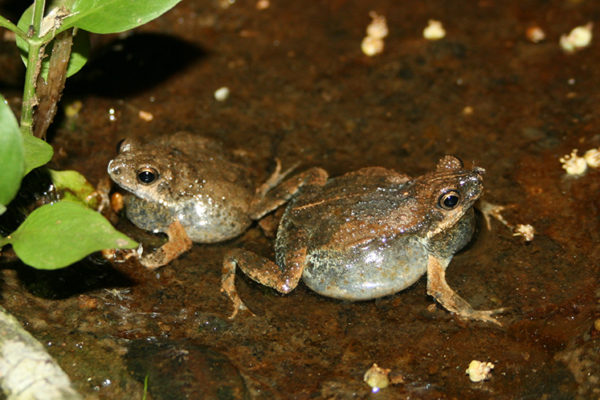Urban sophistication has real sex appeal — at least if you’re a Central American amphibian. Male frogs in cities are more attractive to females than their forest-frog counterparts, according to a new study published in Nature Ecology and Evolution.
Frogs in urban areas have more conspicuous and complex vocal calls, in part because they have fewer predators than those in natural habitats, say scientists from Vrije Universiteit (VU) in the Netherlands, The University of Texas at Austin, Purdue University and the Smithsonian Tropical Research Institute in Panama.
University of Texas at Austin professor of integrative biology Mike Ryan joined team leader biologist Wouter Halfwerk and colleagues to investigate how city life has altered the signaling behavior of male túngara frogs. The trappings of cities often interfere with animal communication, as noise and light pollution affect the visual and auditory signals animals use to attract mates. Halfwerk previously has published work showing how urbanization affects birdsong in Europe.
The research team recorded the characteristic “chuck” calls made by the 1-inch frogs living in forests near the Panama Canal and in nearby human-disturbed areas, including small towns and cities. They found that the urban males would call more often and with greater call complexity, meaning they made more of the “chuck” sounds that females prefer, compared with the frogs in the forest. The authors played back both calls to female frogs in a lab, and they discovered that three-quarters of the females were more attracted to the complex urban calls, compared with the simpler forest calls.
“In the forest, these more attractive calls have a higher cost,” Ryan explained. “The sound can attract frog-eating bats and bloodsucking midges.”
In other words, evolution may select for the trait that allows the frogs to make more complex vocal calls in cities and towns, where the eavesdropping predators are scarcer than in the forest. To help test this idea, the researchers examined what would happen when they moved urban frogs into forest habitats and forest frogs into urban habitats. It turned out that the urban frogs were able to actively reduce the complexity of their calls in the new environment, but forest frogs couldn’t make the switch to making their calls more complex to attract females.
Ryan, his graduate students and colleagues have been studying sexual selection and communication in the túngara frog for decades. His 2018 popular science book “A Taste for the Beautiful” describes how males of this species and other species have evolved to attract more females.
In addition to Ryan and Halfwerk, authors of the study were Michiel Blaas, Lars Kramer, Nadia Hijner and Jacintha Ellers at VU University; Sandra Goutte of the University of New York at Abu Dhabi; and P. Alex Trillo, Ximena Bernal and Rachel Page, all affiliated with the Smithsonian Tropical Research Institute.
Support for the research came from the European Commission, the Netherlands Organisation for Scientific Research, the Royal Netherlands Academy of Arts and Sciences and the National Science Foundation.



